1lumen selects and reviews products personally. We may earn affiliate commissions through our links, which help support our testing.
Olight Arkfeld UV review
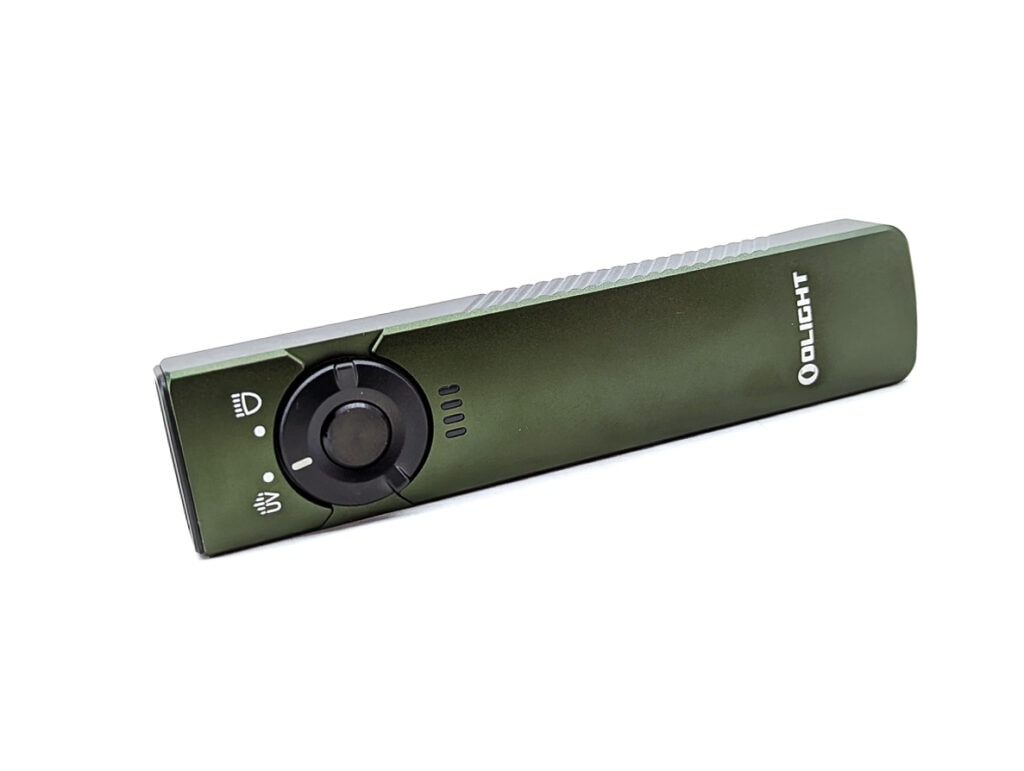
Olight Arkfeld UV specs
| Brand & Model | Olight Arkfeld UV |
|---|---|
| Flashlight category | EDC flashlight |
| LED | ? |
| Max. output | 1,000 lumens |
| Max. beam distance | 85 meters |
| Max. beam intensity | 1,808 cd |
| Battery config. | built-in |
| Onboard charging | Yes, proprietary |
| Modes | 5 |
| Blinkies | Strobe |
| Waterproof | IPX7 |
| Review publication date | March 2023 |
Review intro:
Olight has a pretty broad selection of lights. They make some great keychain lights such as the i3E EOS and the i1R 2 Pro. Olight also has EDC lights like the Baton series. But that’s not all… gun lights, tactical lights, high-power lights, general lamps/lanterns, and now branching out into things like knives and pens. For the most part, if it needs to be lit up, Olight has you covered. One of the things I love most about Olight is their attention to detail. Quality is generally fantastic, and anodizing and machining are great… they just know how to make a solid product.
This particular model – the Olight Arkfeld UV – is a variant of a pretty recent model in the lineup. It’s a nicely portable EDC light that is honestly a bit intriguing. It’s pocketable, it’s rechargeable, it’s easy to use, and well… I gotta leave something for the rest of the review so please read on!
Package quality.
Some Olights come in fantastic heavy-duty two-part nested containers with splashy images of the light inside and meticulously arranged contents. Other lights, like some of the more EDC models, come in nice, but not overdone, packaging that feel like less of a presentation case and more of an actual carton to be recycled. The Arkfeld UV came in one of the latter packages. It’s nice, clean, and gets the point across without investing too much in the box. Sliding out the inner, formed plastic tray reveals:
- Olight Arkfeld UV
- Magnetic charging cable
- Manual
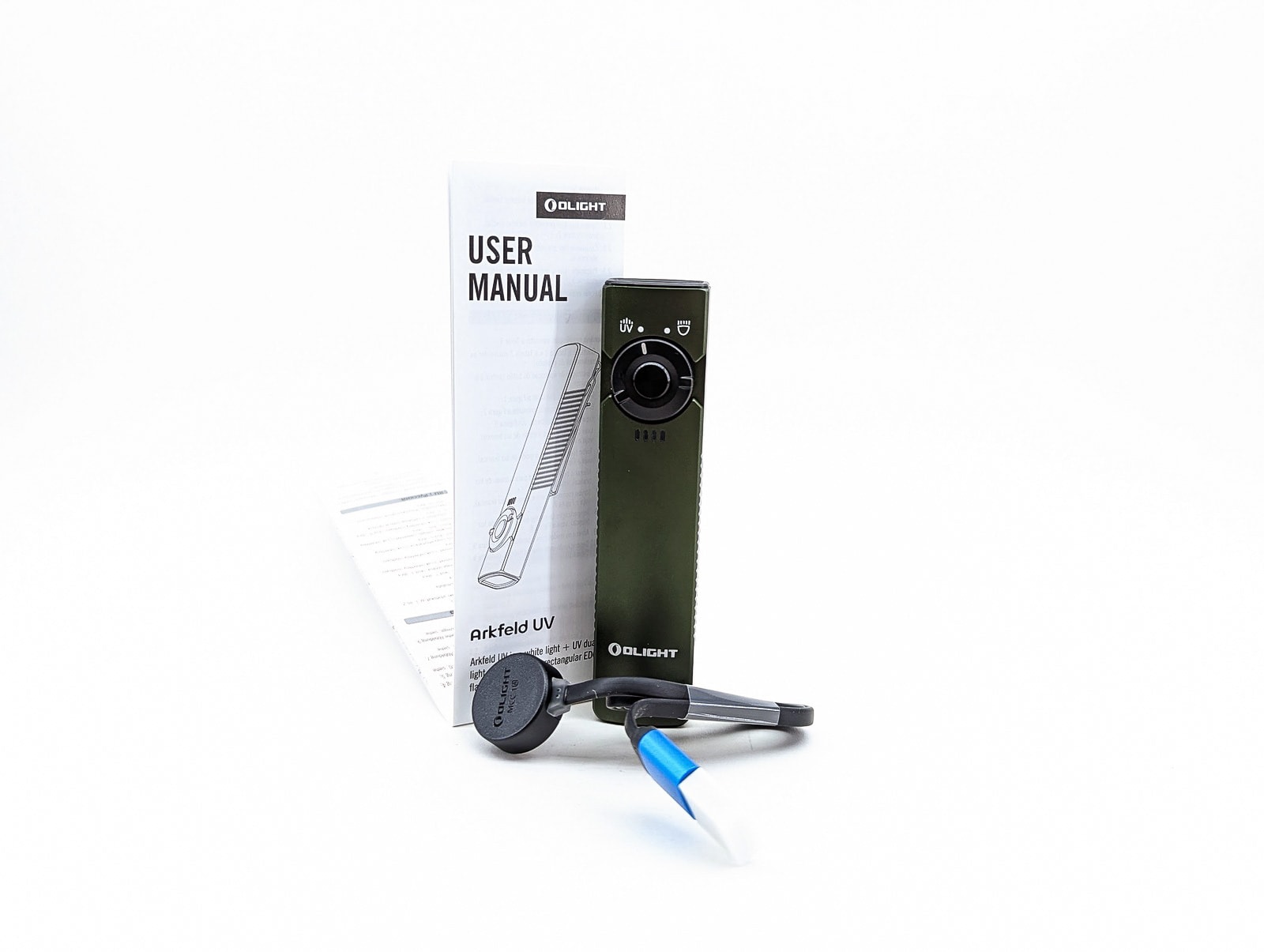
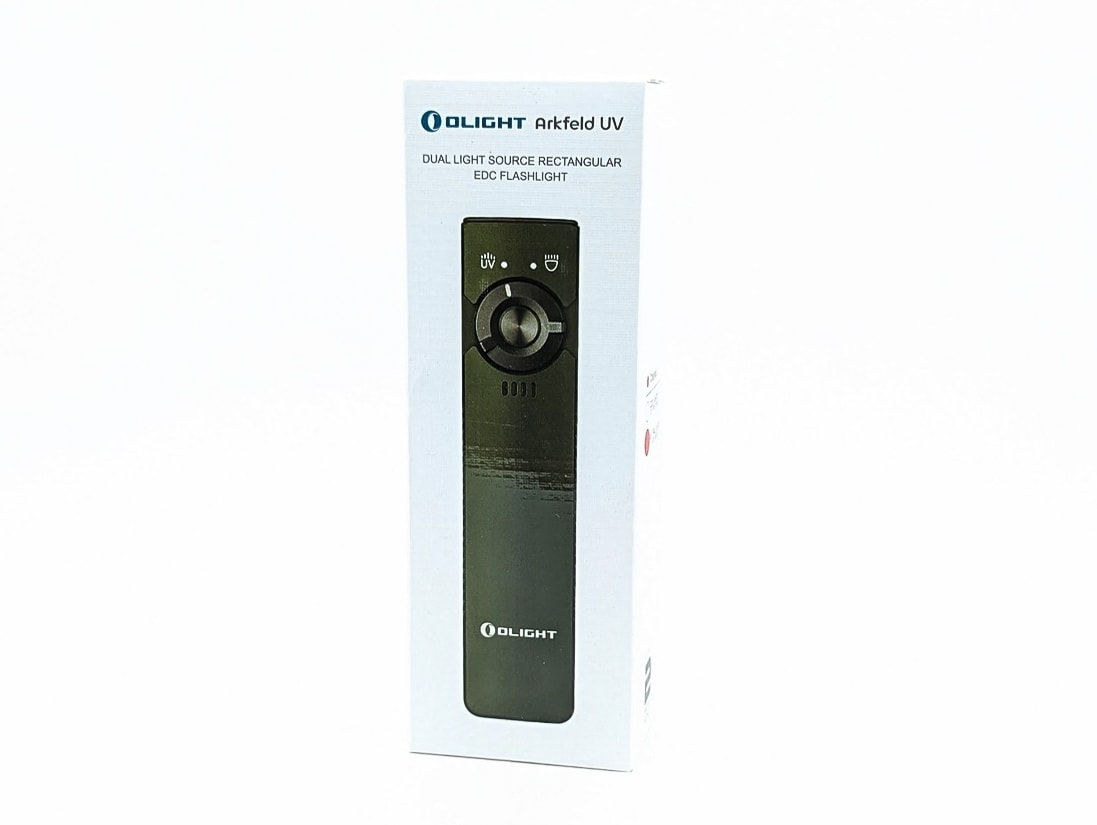
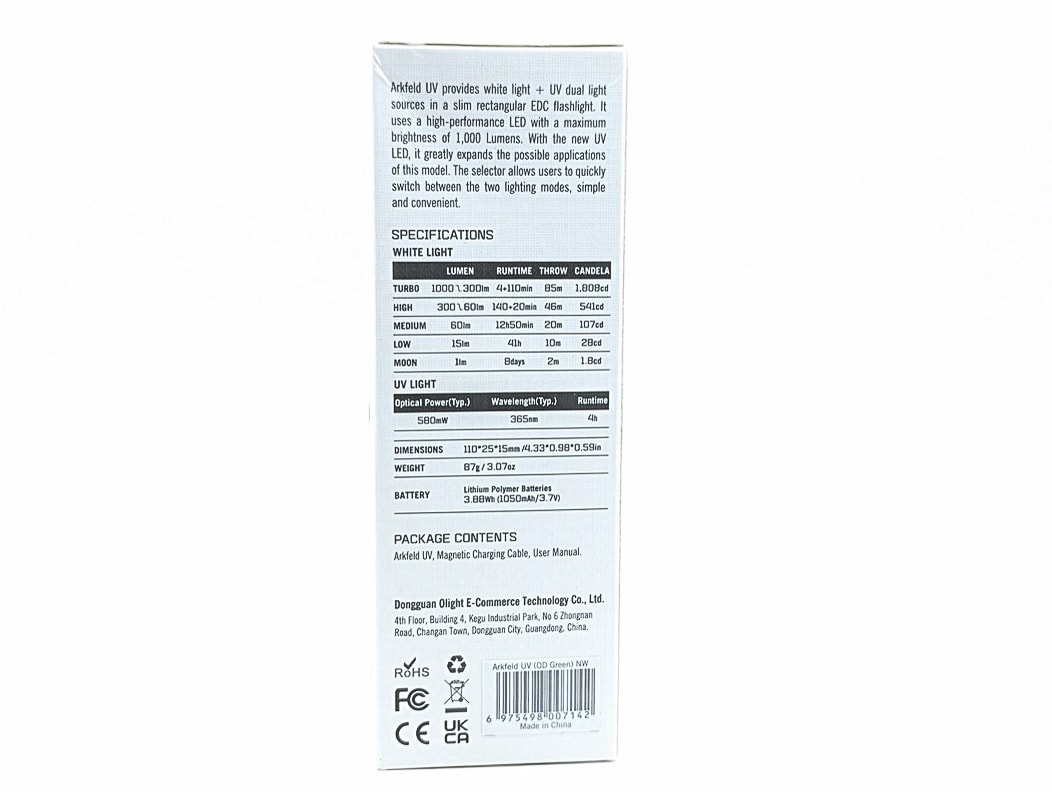
Flashlight in use
Before we go any further – let’s be clear. The Olight Arkfeld UV is an offshoot of a light that was recently released and that I got a chance to review: the Olight Arkfeld. I’d say that the Arkfeld was something truly new and unique. While most flashlights are pretty basic cylindrical (or cylindrical with cones at the end) kind of affairs, the Arkfeld was a self-contained light with an integral battery and charging, a unique shape, and intuitive mode switching between white light and green laser. It was a joy to use and play around with. Everything amazing thing deserves its follow-up though, and thus, the Arkfeld UV seems to have been born. As you might guess, it trades the laser module for a UV LED.
Like when I described the Arkfeld originally, I would say that it doesn’t look like a flashlight at first blush. It bares strong resemblance to a small remote for a TV streaming stick (think Roku or Fire TV) more than anything else. The Arkfeld UV is a fairly flat, rectangle looking thing except that it is rounded a bit on the top and bottom to make it feel more natural in your hand. Unlike the original, though, there is some texture added to the sides of the light. These grippy areas remind me a lot of indents that you would find on a pistol’s slide. This can help with traction if you go to remove the light from your pocket, for example.
The clip is another piece of the Arkfeld UV that has received a change. While the original sported a one-way clip that was quite stout, the Arkfeld UV features a two-way clip. The clip is still fairly strong, but not the beefy thing that used to be there – Olight traded brute strength for overall usefulness.
The clip isn’t the only physical change for the Olight Arkfeld UV. The tail end where the clip attaches has gone on a diet. The aluminum body section is now thinner, with the opening of the clip being positioned at the far end of the light. That makes for true deep-carry pocketing of the Arkfeld UV. The reduced thickness means that there is no longer room for the full MCC charging port. The outer edges of that have been clipped off, though it doesn’t affect functionality at all.
The switch is a bit interesting, though just like its predecessor. It consists of an outer ring and a center button. The outer ring is referred to as the “selector”, as it allows you to switch between the white LED and a UV LED. The ring rotates between two positions, as etched into the body. Point the selector to the left, and you get UV light. Rotate it to the right and you get the white LED output. The ring has two nubs on top that help you to easily rotate it with your thumb. The center button is an e-switch that controls the usual stuff like on/off, mode changes, lockout, etc.
The selector ring sits at about the same height as the center button, so it does give some protection against accidental activations. I had the Arkfeld right in my front jeans pocket for a couple days, and I don’t think it ever activated unintentionally. So it does seem to help, but there is an easy lockout mode if it gives you trouble.
Another thing about that switch…. As I read the manual, I saw it mentioned that “the switch is magnetically sensitive. Its function may be affected by nearby strong magnets.” Oh, well, I’ve gotta test that out. Sure enough, bringing a strong magnet near the switch can force it to switch between UV mode and white LED mode. Interesting observation (precaution?), but not really useful.
This light is very much an EDC kinda light. Having 1000 lumens of moderately floody light is good for things like around the house/office, out for a walk, etc. Oh, and that UV light? It’s actually 365nm which is awesome for a lot of detection scenarios: currency validation, stain detection, etc..
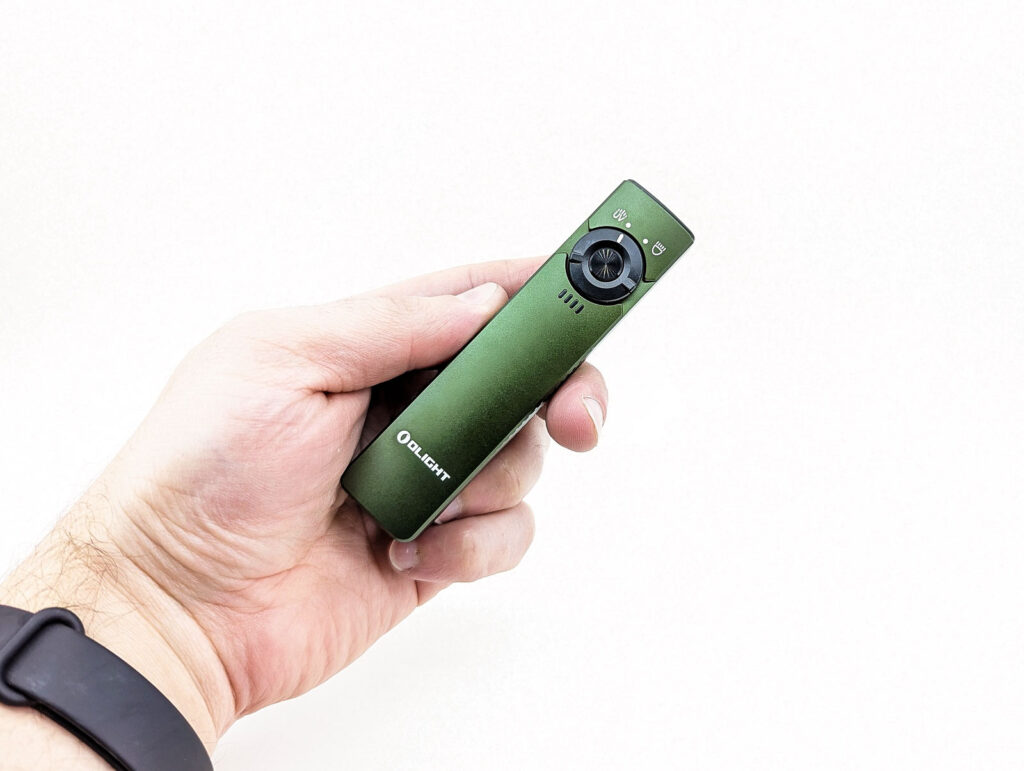
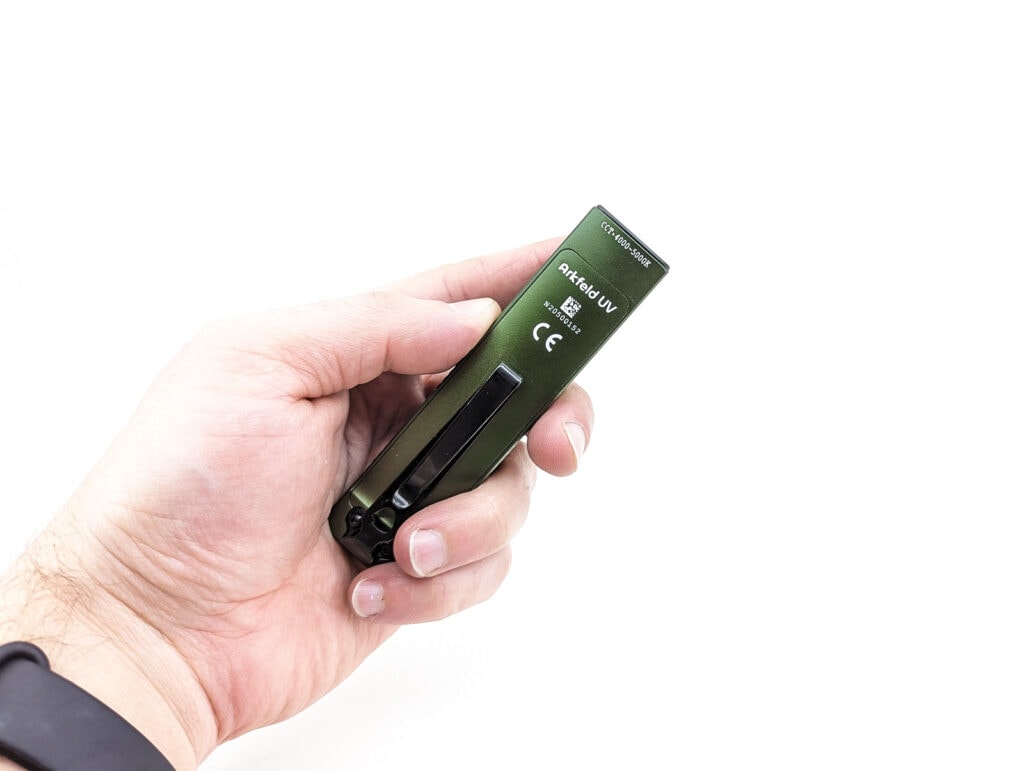
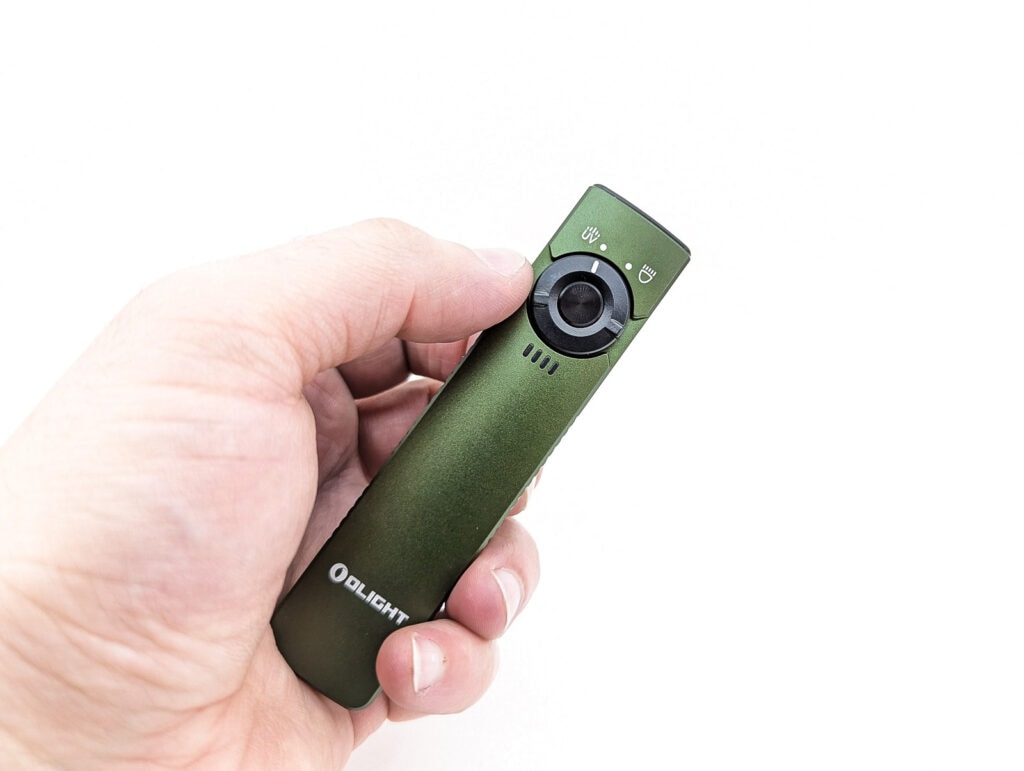
Build Quality and Warranty
As I mentioned earlier, there is no knurling on the Arkfeld. With the exception of the new cuts on the sides of the light, it’s very smooth all the way around. And the finish? Mine is a very nice OD Green. While I don’t know what colors Olight will offer, I imagine we’ll see black and other options. I bet there will be some special colors eventually, too. Most flashlights are pretty boring cylinders with lights at one end. The Arkfeld UV is a nice change in pace for flashlight design, and I appreciated it when companies think outside the box a bit.
Olight’s warranty:
At Olight, we always care about your experience as a customer and want to ensure you have no concerns regarding after-sales service. On September 16th, 2023, we sincerely make the following important promise:
If you purchased an Olight® product from Australia, China, France, Germany or the USA after January 1st, 2023, the local service centers in these countries will honor your LIFETIME WARRANTY for your purchase. If your Olight® product (including its structure, built-in battery, LED, or lens) ever experiences any issues, we promise to take care of it. If we are unable to repair your product, we will promptly replace it with a product in perfect working condition, which will be of equal or better physical condition. If your purchase is a limited or discontinued edition of Olight® product, we will repair or replace it with another Olight® product of the same or higher value.
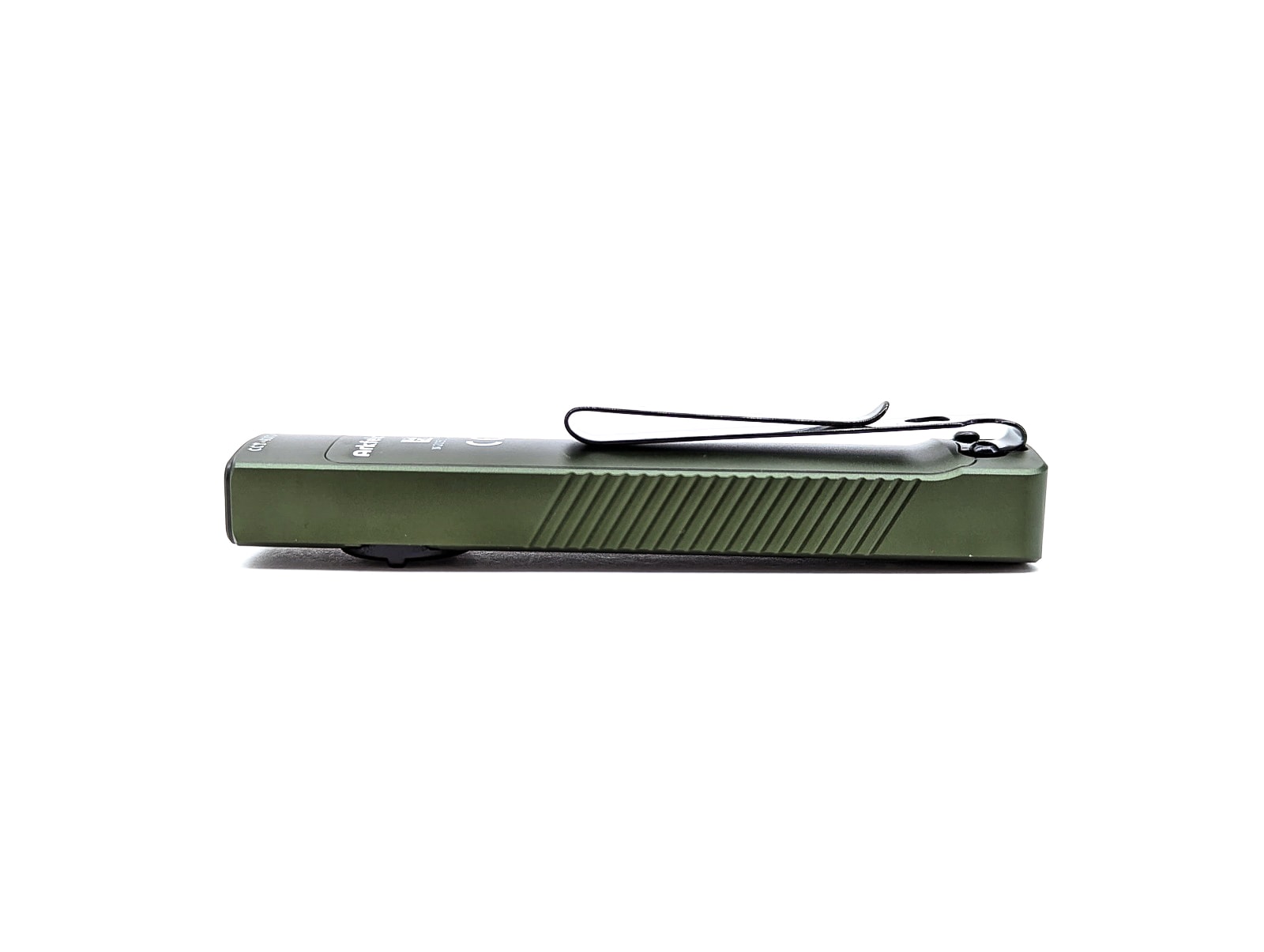
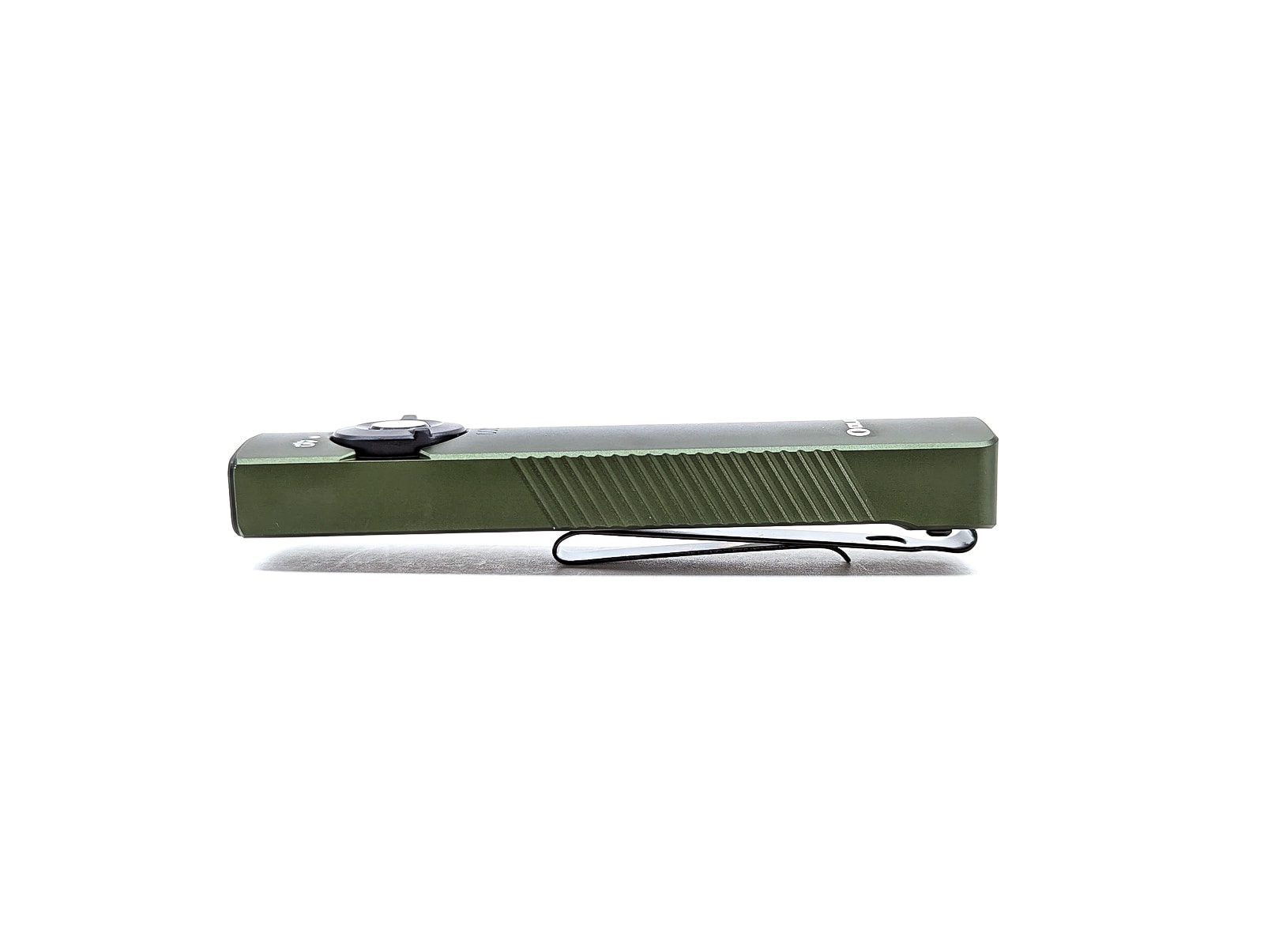
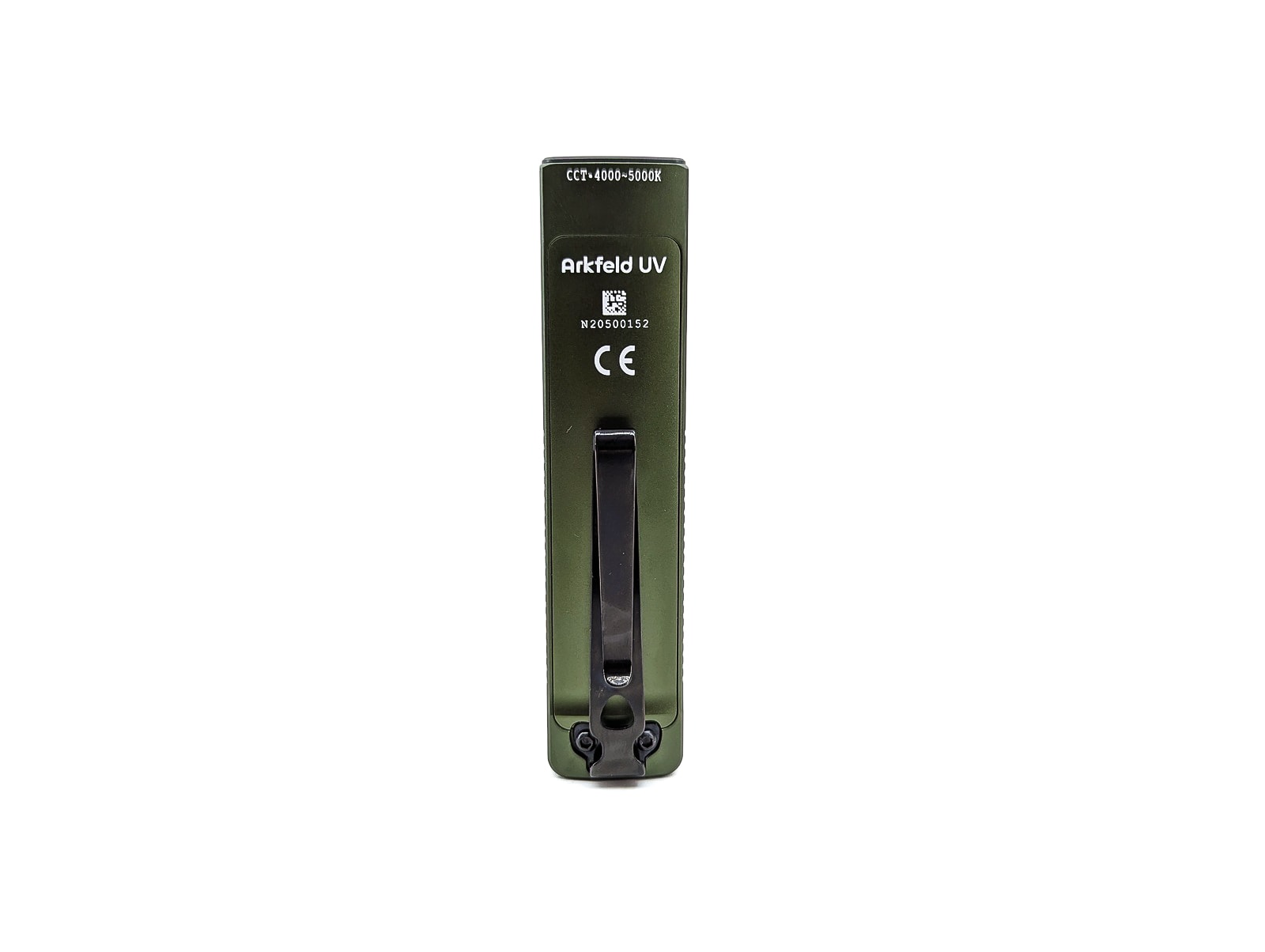
LED, Lens, Bezel, Beam, and Reflector
If there’s one thing that some flashlight enthusiasts like to hate on, it’s the LED and the associated CCT and CRI ratings. There are more than a handful of folks at BudgetLightForum that are all too quick to dismiss Olight because they historically only sold Cool White LEDs. Recently, though, Olight made a pledge to the community to listen to customer feedback. And I think offering CCT options is one of the key ways that Olight is proving this out. The Arkfeld UV is offered in both Cool White (5700-6700K) and Neutral White (4000K-5000K) options. The LED version is clearly labeled on the underside of the flashlight. Olight kindly sent along the requested NW version. They haven’t disclosed what model the LED is, but if I had to guess I’d say maybe it’s an OSRAM P9 or something along those lines.
It’s a bit tough for me to tell what is all stacked at the front of the Olight Arkfeld. There’s certainly a rounded rectangle of something, but I can’t tell if it’s glass over top of optics, or if it’s just a custom optic. I’m guessing it’s glass, especially with shining a UV LED through it. Either way, it’s held in place by a black bezel. As you’re holding it, there is the laser on the left and the right side is occupied by a small TIR optic above a white LED.
Measurements from my Opple Light Master at 3 meters on the Turbo:
- CCT: 4585K
- CRI: 66.7 Ra
- DUV: +0.0072
Oh, and that’s for the white LED. But what about the UV LED? I don’t have any fancy testing equipment for that. It is rated at 580mW of power, and is spec’ed as having a 4-hour runtime. The wavelength clocks in at 365nm, which is my preferred UV wavelength as it seems to do the best with getting common objects to fluoresce. I tried using the Arkfeld UV to illuminate the security strip in a US $100 bill and it was able to do so just fine. The $100 is a bit more difficult to fluoresce than other denominations so I call that a win. I was also shocked at some of the things I found in my house when I took a stroll with the Arkfeld at night – some things I’d probably rather not know about. I will say that though I do like the 365nm choice, this isn’t the perfect UV light. The clear glass allows a certain amount of white light to shine through. If you’re looking for peak UV performance, you might need to check out something with a ZWB2 filter. But for everyday usage, I feel like the Arkfeld UV is great.
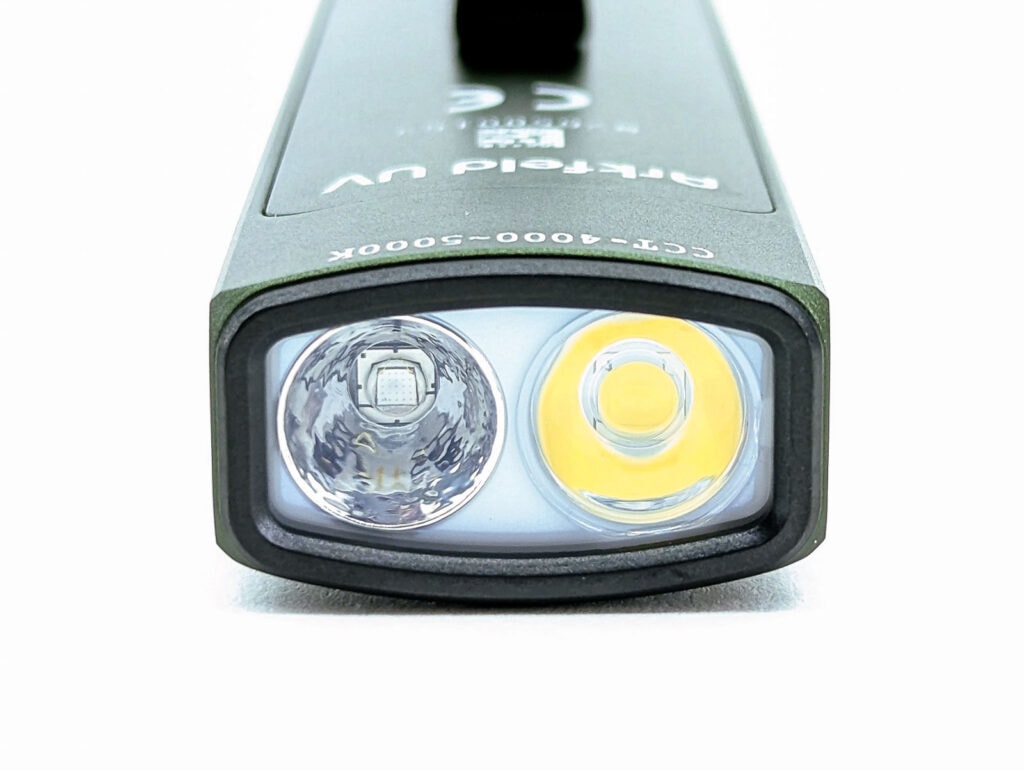
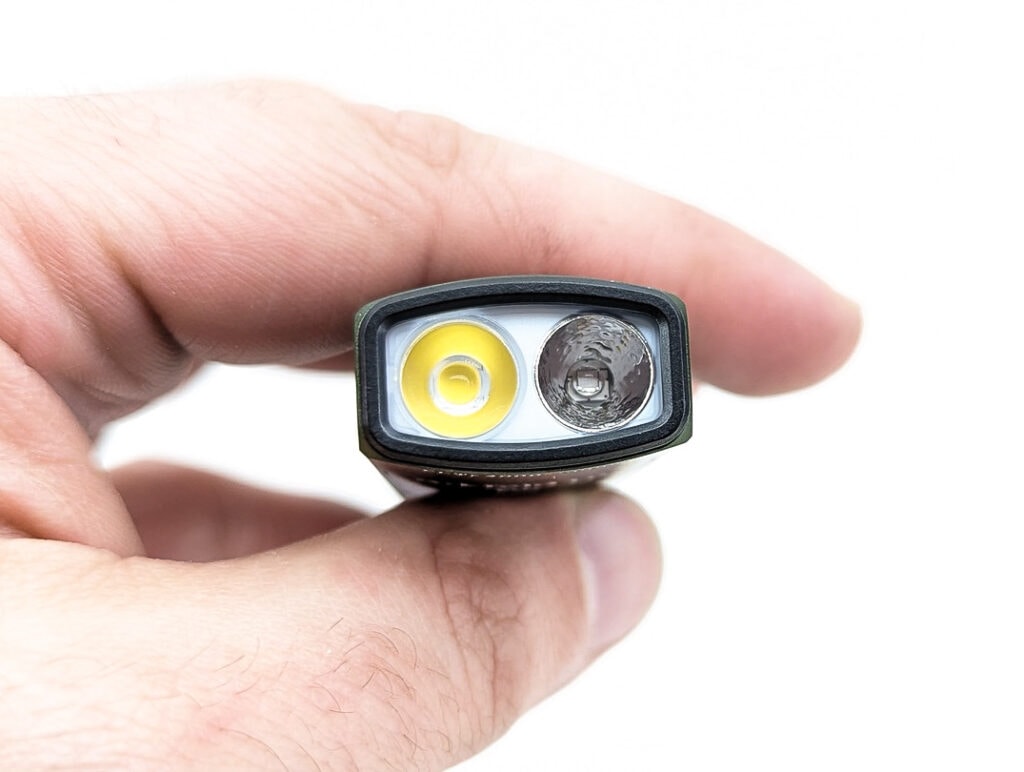
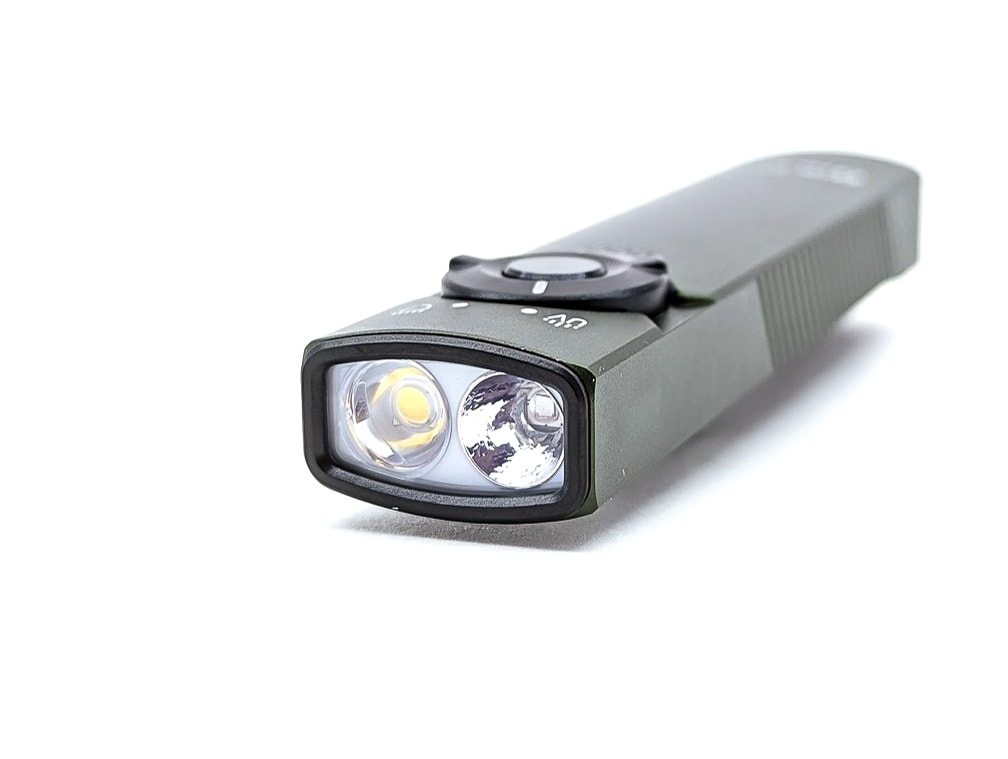
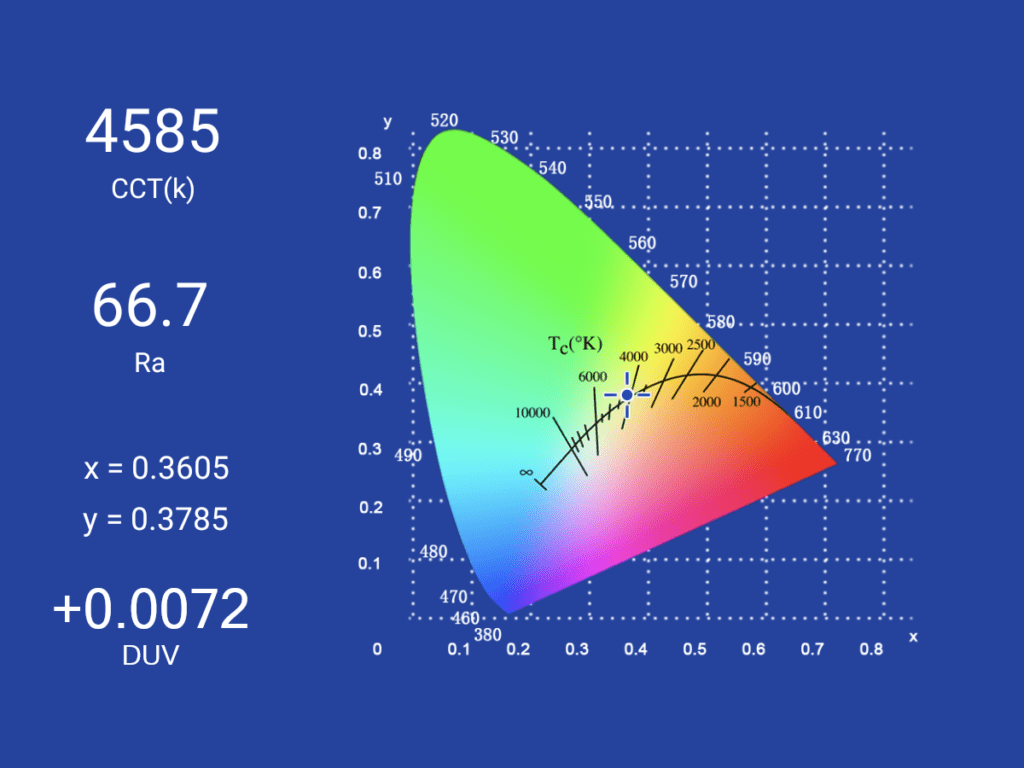
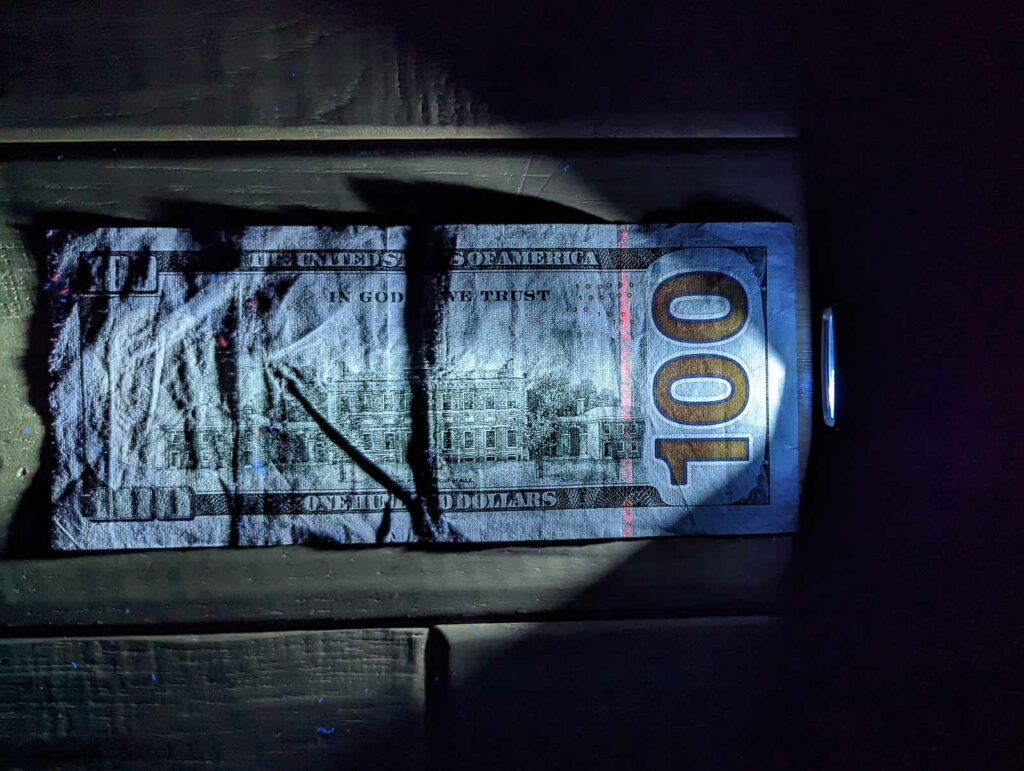
Dimensions and its competition
Dimensions:
| Olight Arkfeld UV | Millimeters | Inches |
|---|---|---|
| Length | 110 mm | 4.3 in |
| Head diameter | 15 mm | 0.6 in |
| Body diameter | 25 mm | 1.0 in |
Dimensions are rounded to the nearest millimeter, and to the nearest tenth of an Inch.
Weight:
| Olight Arkfeld UV | Weight in grams | Weight in oz |
|---|---|---|
| With battery (built-in) | 87 g | 3.1 oz |
Weight is rounded to the nearest gram, and to the nearest tenth of an Oz.
Flashlight size comparison with its competition:
Group 1: Olight Arkfeld UV, Olight Arkfeld
Group 2: Olight Baton 3 Pro Max, Olight Arkfeld UV
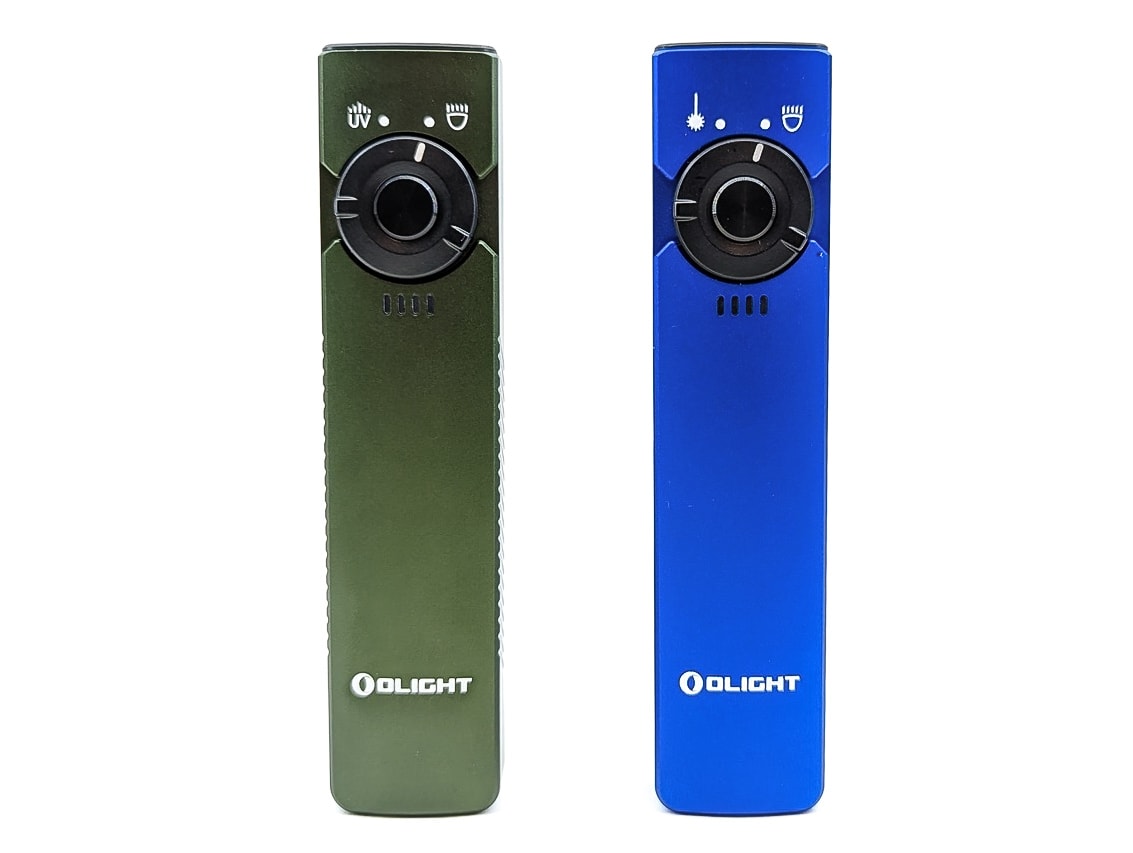
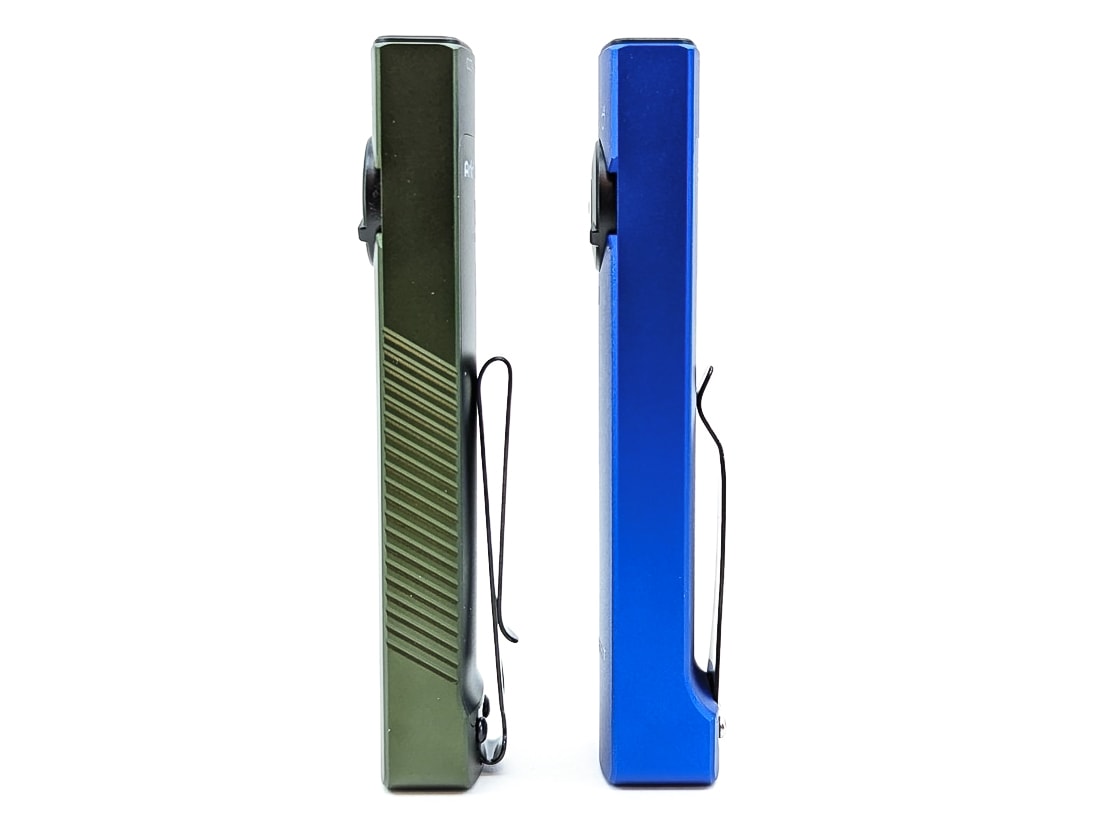
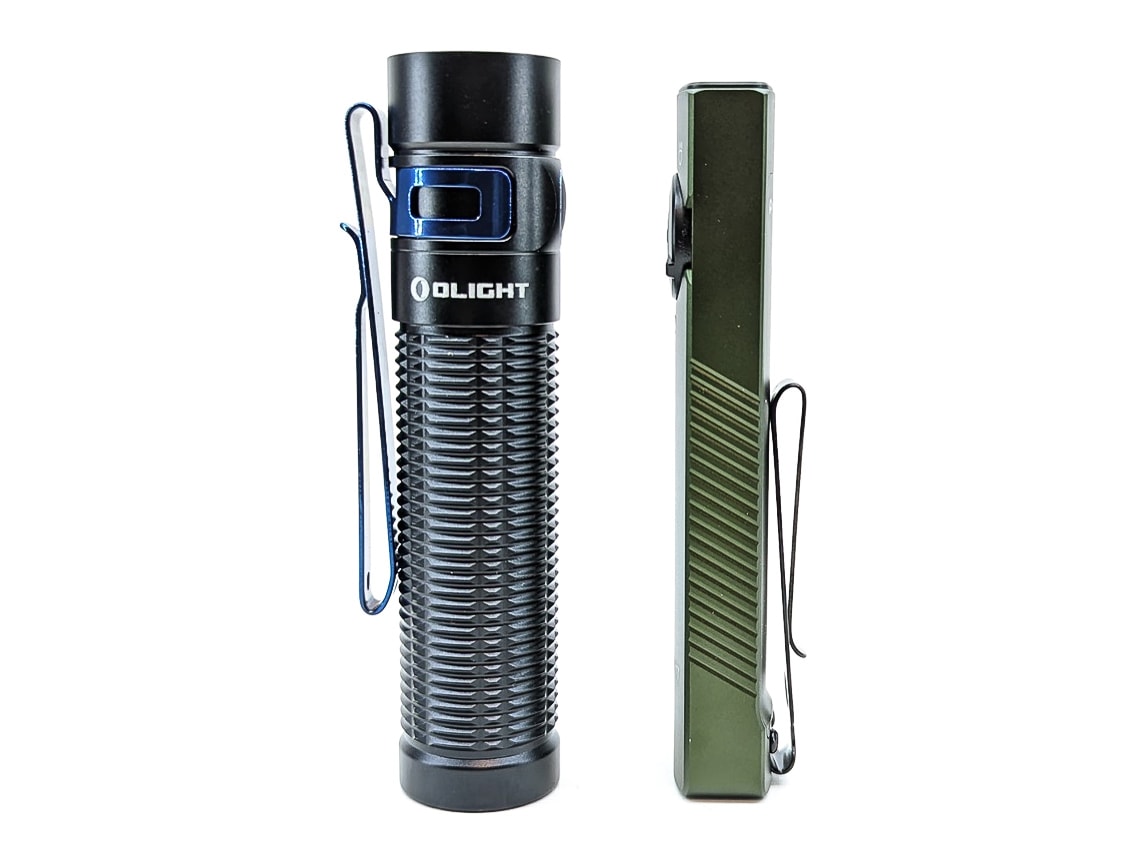
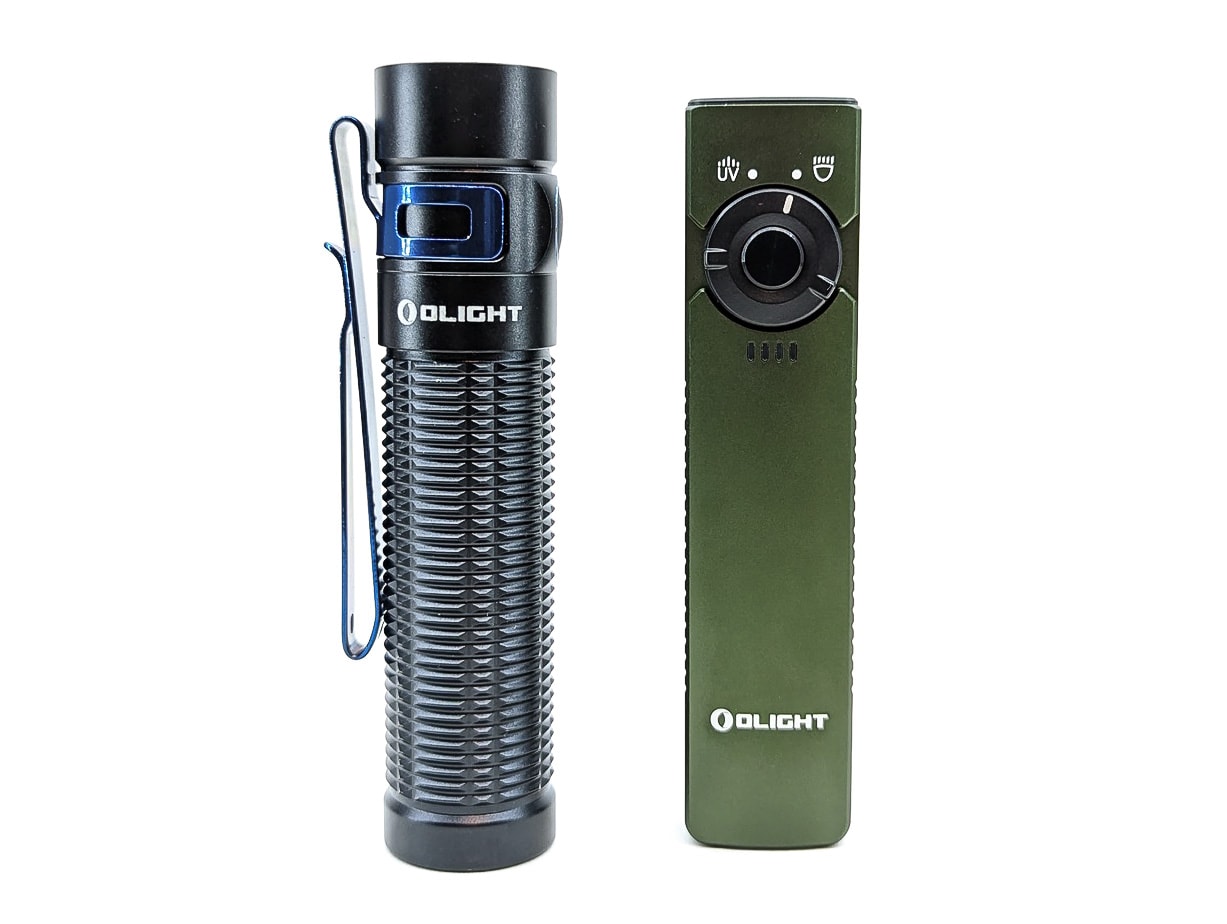
Olight Arkfeld UV UI: User Interface and Driver
The UI is pretty standard stuff and easy to get the hang of if you’ve spent any amount of time with an e-switch light:
Available modes:
- Moon, Low, Med, High, Turbo
Available blinky modes:
- Strobe
User interface:
From OFF:
- Press and Hold 1 second: Moon
- Press and Hold 2+ seconds: Lockout
- Single click: turn On
- Double click: Turbo
- 3 clicks: Strobe
From ON:
- Press and Hold: change modes (Low > Med > High)
- 1 click: turn Off
- Double click: Turbo
- Double click + hold (press & release, press & hold): activate timer
- 3 clicks: Strobe
Mode memory:
- If you turn the light back on within 1 minute of turning it off in Turbo or High, it will come back on in the High
- After 1 minute of being off, Turbo and High modes revert down to Medium mode
- Moon and Low modes will be completely memorized
- Strobe mode cannot be memorized
Shortcuts:
- To Low: press and hold 1 second from Off
- To Turbo: double click (from Off or On)
- To Strobe: triple click (from Off or On)
Low voltage warning:
- There are four LED spots below the selector ring that display the battery level:
- 4 green LEDs lit: >75%
- 3 green LEDs lit: 50-75%
- 2 green LEDs lit: 25-50%
- 1 green LED lit: 10-25%
- 1 red LED lit: <10%
- When turning the Arkfeld on, the indicator lights do a nice sequential ramp up
- After being on for a few seconds, the indicator LEDs turn off (again, in a nice sequential pattern)
- When turning the Arkfeld off, the indicator LEDs turn on again for a few seconds, then turn back off
Strobe/blinkies
- There is a strobe mode that can be activated with a triple click from Off or On
Lock-out mode:
- Electronic lockout mode is enabled by holding the button down for 2+ seconds while the light is off
PWM
- There is no PWM present
Additional info on the UI:
- With the selector ring in the UV position, the only UI options are single click Off & On, plus lockout
- There is also a neat Timer mode, as seen on other Olights.
- With the light on and in your desired mode, do a double click + hold (press & release, press & hold) until you see a blink.
- One blink means that you activated a 3-minute timer.
- Two blinks mean that you activated a 9-minute timer.
- To switch between the 3-minute and 9-minute timers, after you’ve activated the timer, do another double click + hold.
- Your timer preference (3 minutes versus 9 minutes) will be memorized for next time.
Olight Arkfeld UV Charging and batteries
The Olight Arkfeld UV uses a built-in battery. Olight says that the capacity of the battery is 3.88 Wh (1050 mAh / 3.7 V). A charging test showed that 4.32 Wh was transferred, which seems right in line when you consider that charging isn’t perfectly efficient. Olight says the charge rate using the supplied MCC (magnetic charging cable) is 1 amp and a charge cycle should take around 2 hours. My tests showed that to hold true, observing a charge rate of 0.87 amps and taking 2 hours and 9 minutes to complete the charge cycle.
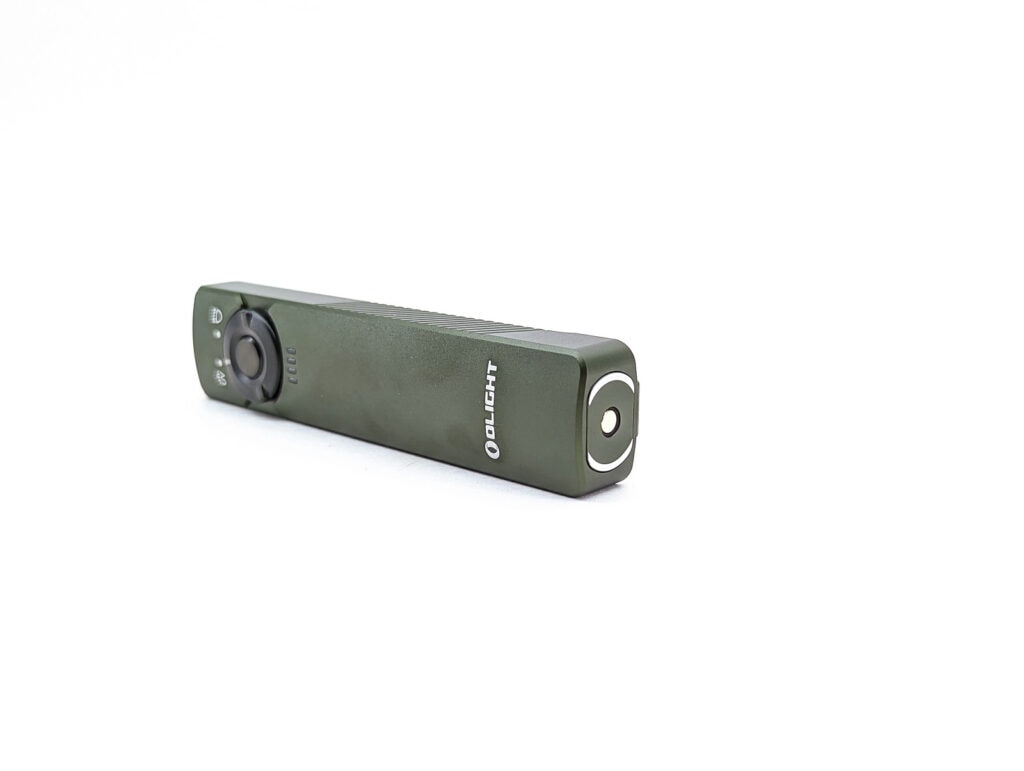
Performance test
Lux was measured by a UNI-T UT383 BT at 5 meters. Lumens were measured in a homemade lumen tube using a VEML7700 sensor, and calibrated with a calibration light provided by 1Lumen. Due to the built-in nature of the battery, current tests were not possible.
Lumen measurements (for each mode)
| Mode | Specs | turn on | 30 sec | 10 minutes |
|---|---|---|---|---|
| Moon | 1 lm | 0.7 lm | 0.7 lm | – |
| Low | 15 lm | 11 lm | 11 lm | – |
| Med | 60 lm | 43 lm | 42 lm | 42 lm |
| High | 300 > 60 lm | 258 lm | 258 lm | 257 lm |
| Turbo | 1000 > 300 lm | 886 lm | 874 lm | 255 lm |
The output measured around 10% lower than spec. That’s a bit unusual for Olight, but consistent with what I measured on the original Arkfeld so it’s not a total surprise.
Parasitic drain:
- unable to measure
Battery Life: Runtime graphs
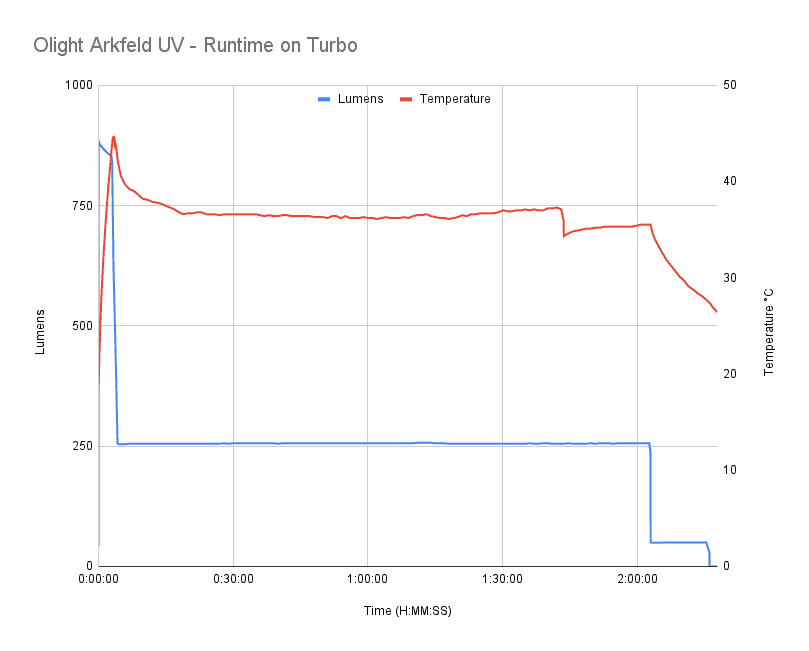
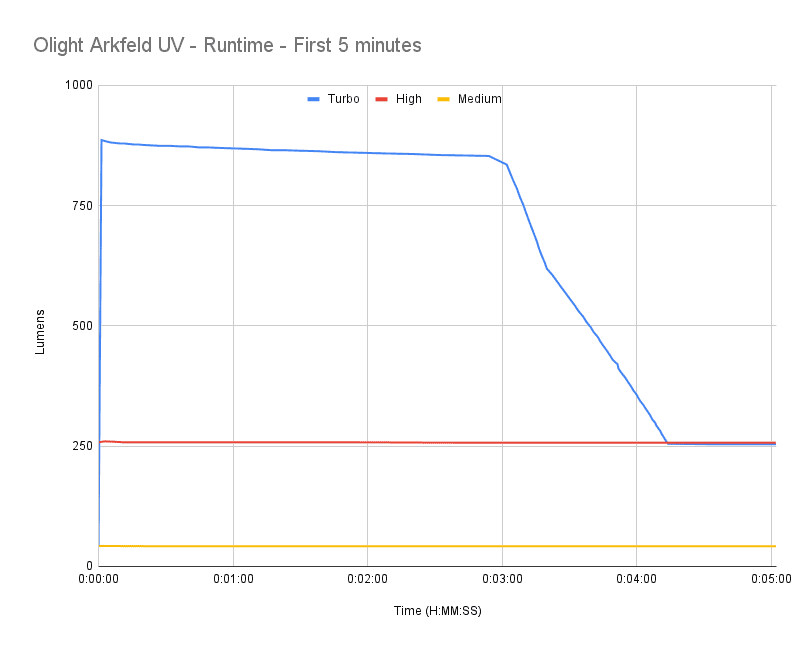
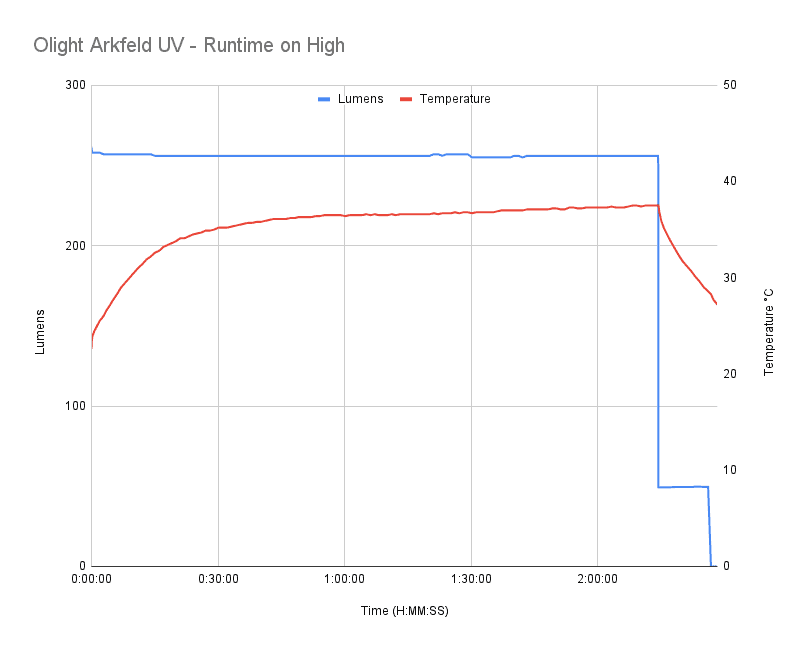
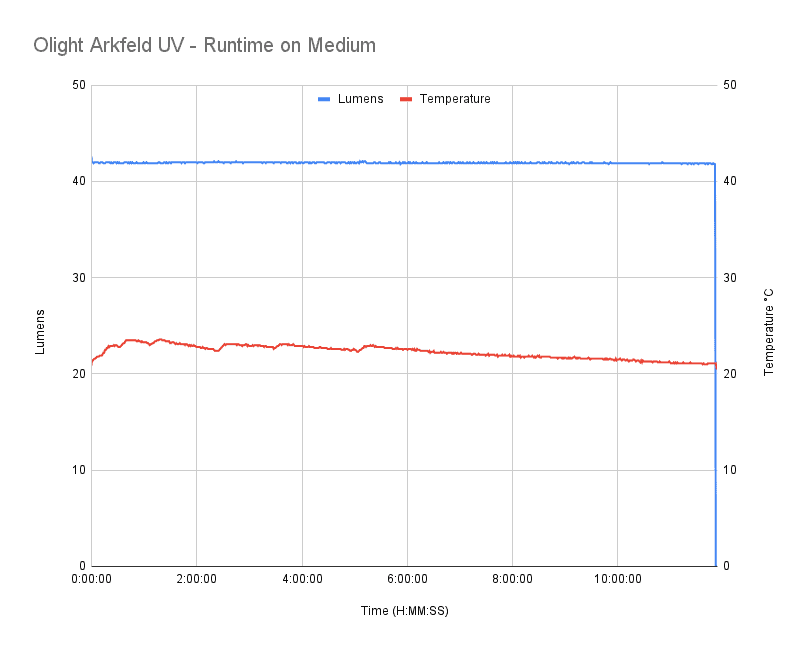
| Mode | Specified | Measured runtime ANSI | Time till shut off |
|---|---|---|---|
| Moon | 8 days | – | – |
| Low | 41h | – | – |
| Med | 12h 50min | 11h 51min | 11h 51min |
| High | 2h 40min | 2h 26min | 2h 26min |
| Turbo | 1h 54min | 2h 3min | 2h 16min |
| UV mode | 4h | – | – |
Overall, the runtime durations are consistent with the Olight specs. Medium was a bit shorter than expected.
About ANSI FL1 standards: The runtime is measured until the light drops to 10% of its initial output (30 seconds after turning on). This does not mean that the flashlight is not usable anymore. The last column shows how long the light actually works till it shuts off. If there is a + symbol, it means that the test was stopped at that particular point, but the light was actually still running. This happens on certain occasions, with certain drivers, firmware, or batteries.
Peak beam intensity and beam distance measurements
The intensity was measured at 5 meters after being turned on for 30 seconds. A UNI-T UT383 BT lux meter was used.
| Mode | Specs | Candela measured | Meters | Yards |
|---|---|---|---|---|
| Moon | 1.8 cd | – | – | – |
| Low | 28 cd | 20 cd | 9 m | 10 yd |
| Medium | 107 cd | 92 cd | 19 m | 21 yd |
| High | 541 cd | 550 cd | 47 m | 51 yd |
| Turbo | 1,808 cd | 1,900 cd | 87 m | 95 yd |
My beam intensity numbers closely match Olight’s claims. I did notice that the beam intensity of the Arkfeld UV (1,808 cd) is lower than the original Arkfeld (2,560 cd).
About peak beam intensity: Peak beam distance according to ANSI FL1 standards: The calculated value of distance in meters at which the flashlight produces a light intensity of 0.25 lux. (0.25 lux is about the brightness of a full moon shining on an object). The columns ‘Meters’ and ‘Yards’ use rounded numbers.
Beamshots
Camera settings and distance:
Beam shots of the building are taken at 30 m (33 yd) using a Pixel 7 set to ISO 800 with 1/10 second exposure time
Beamshots of the following flashlights compared:
- Olight Arkfeld UV
- Olight Baton 3 Pro Max
- Sofirn SP35
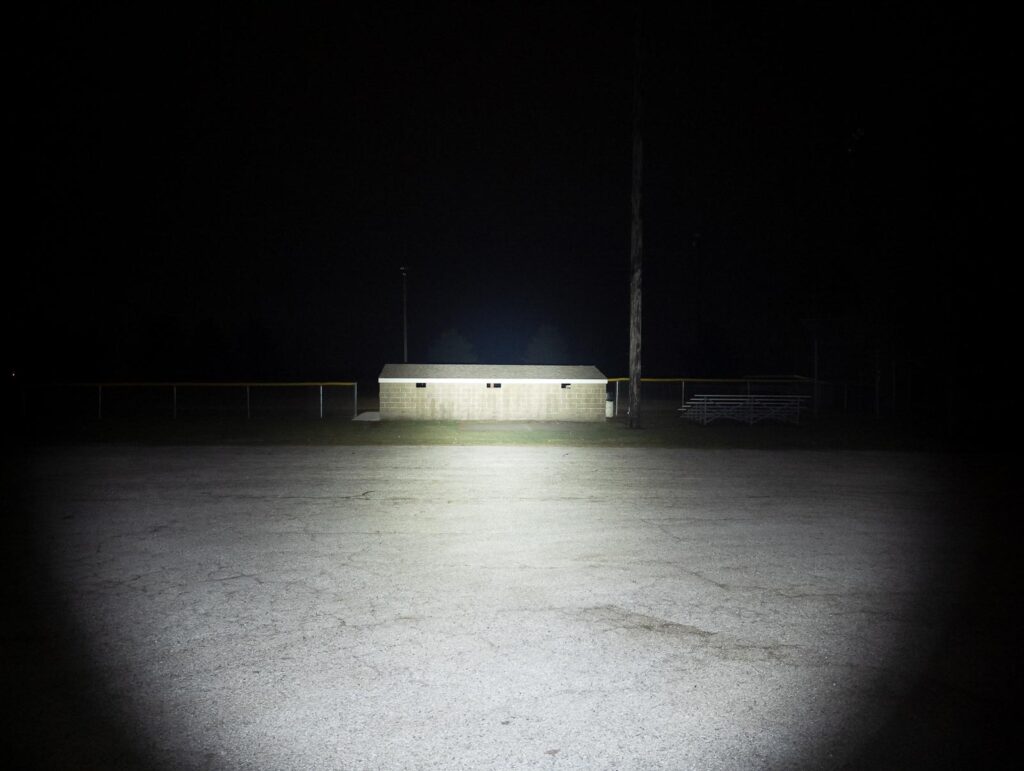
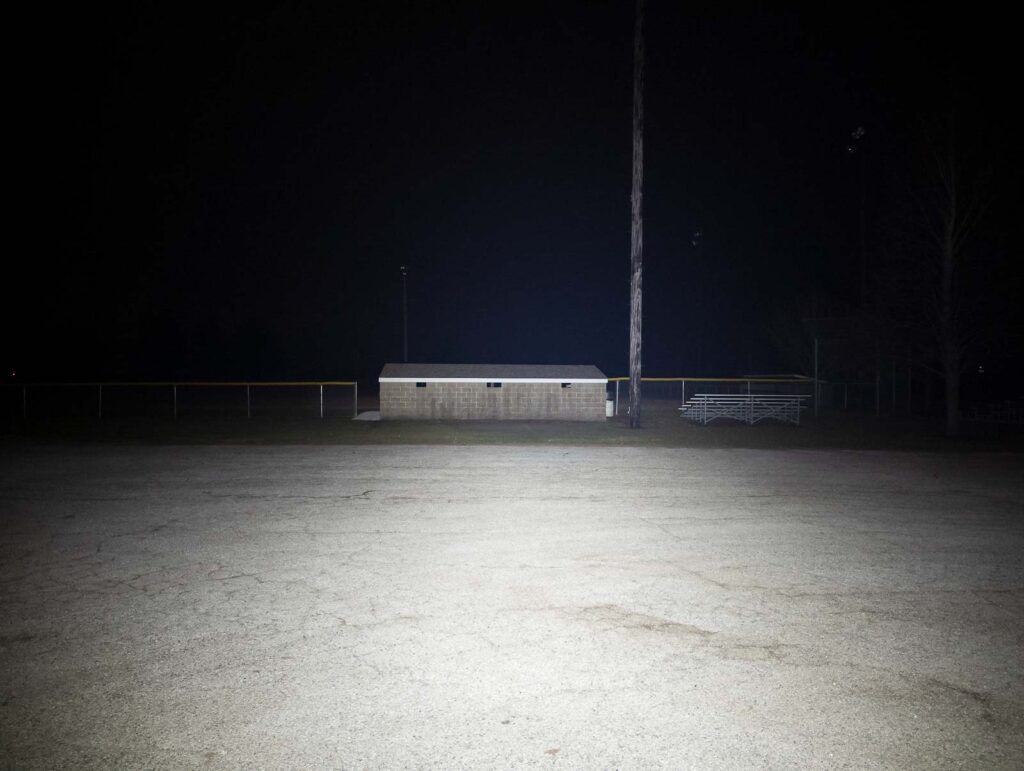
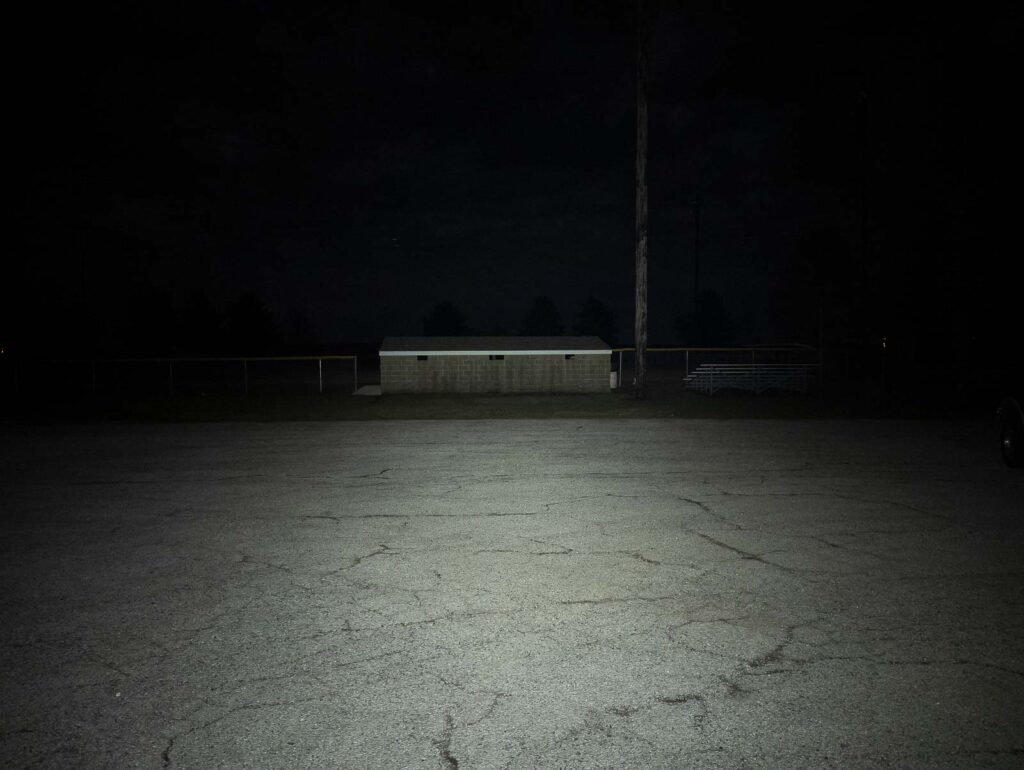
Disclaimer: This flashlight was sent to me for review at no cost by Olight. I have not been paid to review, nor have I been holding back on problems or defects.
Final Verdict
Pros
- Unique design
- CCT choices
- Simple UI
- Good UV performance (365nm)
- Great regulation
- Easy battery level indication
- Magnetic charging
Cons
- Beam is above the BBL
- Slim, but not small
- Misses lumen spec
Explanation on star ratings:
1: Avoid: a match would be a better choice – 2: Poor: significant defect or issues; almost unusable – 3: Average: some defects or issues; but still usable 4: Good: recommended (minor issues) – 5: Great: highly recommended

5 stars: ★★★★★
The new Olight Arkfeld UV is a great piece of kit. It features an eye-catching design with its rectangular shape, slim dimensions, and unique design. The Arkfeld UV’s selector ring and center button make it easy to use and a breeze to switch between the white LED and 365nm UV outputs.
Speaking of LEDs, Olight is living up to the promise of listening to customer feedback and is offering both Cool White (5700-6700K) and Neutral White (4000-5000K) versions, though both are standard 70-CRI and my NW version is slightly above the BBL. Tint nit-picks aside, these features add up to a really nice EDC light. The Arkfeld UV is another great option from Olight.
Buy your Olight Arkfeld UV with a discount
Use our exclusive 1lumen discount code to get an extra 10% off anything you order at Olightstore.com (USA). Coupon code: 1lumen
1lumen selects and reviews products personally. We may earn affiliate commissions through our links, which help support our testing.
